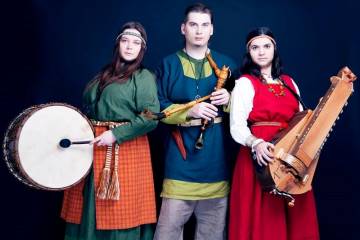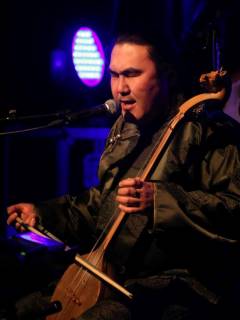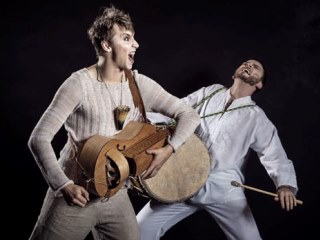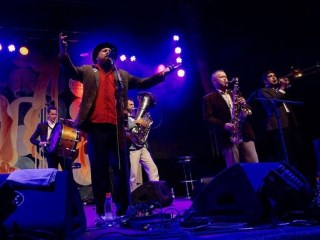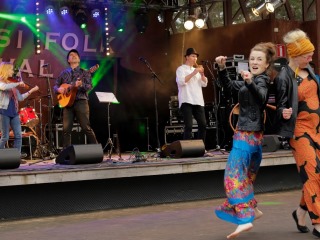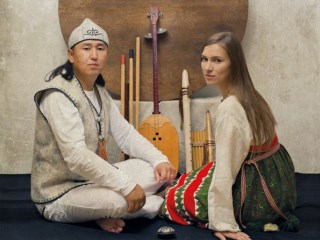FolkWorld #72 07/2020
Folk & Great Tunes from Russia
This new compilation consists of all genres and ways modern folk music is imagined and performed in the Russian Federation.
Music of Russia denotes music produced from Russia and/or by Russians. Russia is a large and culturally diverse country, with many ethnic groups, each with their own locally developed music. Russian music also includes significant contributions from ethnic minorities, who populated the Russian Empire, the Soviet Union and modern-day Russia.

- Christian Pliefke (CPL Music)
Ayarkhaan | Dobranotch | Taisia Krasnopevceva | Belukha Jam | Staritsa | Radik Tyulyush | Valeriya Shaportova | Vedan Kolod | Merema | Alyona Minulina | Eduard Andrianov | Varevo | Sage | TurboZen | ShooDJa-ChooDJa | Dmitry Paramonov | Nachni s nachala | Sattuma | Scythian Trace | Etnozapil | Beneath Clouds | Merema | Karjala | Radik Tyulyush | Zubcy | Zemlya Legend | Juncti | Grey-haired Ural | Juna | Staritsa | Kosmonavty | Gilead |
Various Artists "Folk & Great Tunes from Russia", CPL Music, 2020
Russian music went through a long history, beginning from ritual folk songs and the sacred music of the Russian Orthodox Church. The 19th century saw the rise of highly acclaimed Russian classical music, and in the 20th century major contributions by various composers such as Igor Stravinsky as well as Soviet composers, while the modern styles of Russian popular music developed, including Russian rock, Russian hip hop and Russian pop.
History
Early history
Written documents exist that describe the musical culture of the Rus'. The most popular kind of instruments in medieval Russia were thought to have been string instruments, such as the gusli or gudok. Archeologists have uncovered examples of these instruments in the Novgorod region dating as early as 11th century. (Novgorod republic had deep traditions in music; its most popular folk hero and the chief character of several epics was Sadko, a gusli player). Other instruments in common use include flutes (svirel), and percussive instruments such as the treshchotka and the buben. The most popular form of music, however was singing. Bylinas (epic ballads) about folk heroes such as Sadko, Ilya Muromets, and others were often sung, sometimes to instrumental accompaniment. The texts of some of these epics have been recorded.
In the period of Muscovy, two major genres formed Russian music: the sacred music of the Orthodox Church and secular music used for entertainment. The sacred music draws its tradition from the Byzantine Empire, with key elements being used in Russian Orthodox bell ringing, as well as choral singing. Neumes were developed for musical notation, and as a result several examples of medieval sacred music have survived to this day, among them two stichera composed by Tsar Ivan IV in the 16th century.
Secular music included the use of musical instruments such as fipple flutes and string instruments, and was usually played on holidays initially by skomorokhs – jesters and minstrels who entertained the nobility. During the reactionary period of the Great Russian Schism in the 17th century, skomorokhs along with their form of secular music were banned from plying their trade numerous times, their instruments were burned and those who disagree with Alexis of Russia's 1648 law "About the correction of morals and the destruction of superstitions" (Об исправлении нравов и уничтожении суеверий) were punished physically first and then were to be deported to Malorossia (modern Ukraine), but despite these restrictions, some of their traditions survived to the present day.
Ethnic roots music
Russia today is a multi-ethnic state with over 300 ethnicities living under one flag. Each of these ethnic groups has their own indigenous folk, sacred and in some cases art music, which can loosely be categorized together under the guise of ethnic roots music, or folk music. This category can further be broken down into folkloric (modern adaptations of folk material, and authentic presentations of ethnic music).
Adygea
In recent years, Adygea has seen the formation of a number of new musical institutions. These include two orchestras, one of which (Russkaya Udal) uses folk instruments, and a chamber music theater.
Adygea's national anthem was written by Iskhak Shumafovich Mashbash with music by Umar Khatsitsovich Tkhabisimov.
Altay
Altay is a Central Asian region, known for traditional epics and a number of folk instruments.
Bashkir
The first major study of Bashkir music appeared in 1897, when ethnographer Rybakov S.G. wrote Music and Songs of the Ural's Muslims and Studies of Their Way of Life. Later, Lebedinskiy L.N. collected numerous folk songs in Bashkortostan beginning in 1930. The 1968 foundation of the Ufa State Institute of Arts sponsored research in the field.
The kurai is the most important instrument in the Bashkir ensemble.
Buryatia
The Buryats of the far east is known for distinctive folk music which uses the two-stringed horsehead fiddle, or morin khuur. The style has no polyphony and has little melodic innovation. Narrative structures are very common, many of them long epics which claim to be the last song of a famous hero, such as in the "Last Song of Rinchin Dorzhin". Modern Buryat musicians include the band Uragsha, which uniquely combines Siberian and Russian language lyrics with rock and Buryat folk songs, and Namgar, who is firmly rooted in the folk tradition but also explores connections to other musical cultures.
Chechnya
Alongside the Chechen rebellion of the 1990s came a resurgence in Chechen national identity, of which music is a major part. People like Said Khachukayev became prominent promoting Chechen music.
The Chechen national anthem is said to be "Death or Freedom", an ancient song of uncertain origin.
Dagestan
Dagestan's most famous composer may be Gotfrid Hasanov, who is said to be the first professional composer from Dagestan. He wrote the first Dagestani opera, Khochbar, in 1945 and recorded a great deal of folk music from all the peoples of Dagestan.
Karelia
Karelians are Finnish, and so much of their music is the same as Finnish music. The Kalevala is a very important part of traditional music; it is a recitation of Finnish legends, and is considered an integral part of the Finnish folk identity.
The Karelian Folk Music Ensemble is a prominent folk group.
Ossetia
Ossetians are people of the Caucasian Region, and thus Ossetian music and dance have similar themes to the music of Chechnya and the music of Dagestan.
Russia
Archeology and direct evidence show a variety of musical instruments in ancient Russia. Authentic folk instruments include the Livenka (accordion) and woodwinds like zhaleika, svirel and kugikli, as well as numerous percussion instruments: buben, bubenci, kokshnik, korobochka, lozhki, rubel, treschetka, vertushka and zvonchalka.
Chastushkas are a kind of Russian folk song with a long history. They are typically rapped, and are humorous or satiric.
During the 19th century, Count Uvarov led a campaign of nationalist revival which initiated the first professional orchestra with traditional instruments, beginning with Vasily Andreyev, who used the balalaika in an orchestra late in the century. Just after the dawn of the 20th century, Mitrofan Pyatnitsky founded the Pyatnitsky Choir, which used rural peasant singers and traditional sounds.
Sakha
Shamanism remains an important cultural practice of the ethnic groups of Siberia and Sakhalin, where several dozen groups live. The Yakuts are the largest, and are known for their olonkho songs and the khomus, a jaw harp.
Tatarstan
Tatar folk music has rhythmic peculiarities and pentatonic intonation in common with nations of the Volga area, who are ethnically Finno-Ugric and Turkic. Singing girls, renowned for their subtlety and grace, are a prominent component of Tatar folk music. Instruments include the kubyz (violin), quray (flute) and talianka (accordion).
Tuva
Tuvan throat singing, or xoomii, is famous worldwide, primarily for its novelty. The style is highly unusual and foreign to most listeners, who typically find it inaccessible and amelodic. In throat singing, the natural harmonic resonances of the lips and mouth are tuned to select certain overtones. The style was first recorded by Ted Levin, who helped catalogue a number of different styles. These include borbannadir (which is compared to the sound of a flowing river), sygyt (similar to whistling), xoomii, chylandyk (likened to chirping crickets) and ezengileer (like a horse's trotting). Of particular international fame are the group Huun-Huur-Tu and master throat singer Kongar-ool Ondar.
Ukrainian music in Russia
Although Ukraine is an independent country since 1991, Ukrainians constitute the second-largest ethnic minority in Russia. The bandura is the most important and distinctive instrument of the Ukrainian folk tradition, and was used by court musicians in the various Tsarist courts. The kobzars, a kind of wandering performers who composed dumy, or folk epics. Many of the early classical composers of Russia such as Dmitry Bortniansky, Maksym Berezovsky, Artemy Vedel, and a significant number of others, were of Ukrainian descent.
Russian traditional music
Russian traditional music specifically deals with the folk music traditions of the ethnic Russian people. It does not include the various forms of art music, which in Russia often contains folk melodies and folk elements or music of other ethnic groups living in Russia.
Ethnic styles in the modern era
The performance and promulgation of ethnic music in Russia has a long tradition. Initially it was intertwined with various forms of art music, however, in the late 19th century it began to take on a life of its own with the rise in popularity of folkloric ensembles, such as the folk choir movement led by Mitrofan Pyatnitsky and the Russian folk instrument movement pioneered by Vasily Andreyev.
In Soviet Russia, folk music was categorized as being democratic (of the people) or proletarian (of the working class) as opposed to art music, which was often regarded as being bourgeois. After the revolution, along with proletarian "mass music" (music for the proletarian masses) it received significant support from the state. In Post World War II Russia, proletarian mass music however lost its appeal, whereas folkloric music continued to have a widespread support among the population, inside and outside of the Soviet Union. However the authentic nature of folk music was severely distorted by the drive to 'professionalise' performers, regardless of the genre they worked in: thus all folk singers were obliged to both learn Western-style classical notation, and to learn to perform classical repertoire – or else risk losing their right to perform as 'professionals'.
In the 1960s, folk music in Russia continued to receive significant state support and was often seen as the antithesis of Western pop music. The fact that numerous Soviet folkloric ensembles were invited for foreign tours raised the prestige of the folk performer to that of academic musicians, and in some cases even higher because access to the West and Western goods was very desirable.
Ethnic (folk) music in Russia can often be categorized according to the amount of authenticity in the performance: truly authentic folk music (reproductive performances of traditional music), folkloric and "fakeloric" performance.
Russia is a multi-ethnic country with some 300 different ethnic groups, many of them non-Slavic, living within its borders. This article deals specifically with just Russian ethnic music.
Authentic folk music
This music is closely tied in with village life and traditions. It was usually not performed by professional musicians. From the Central Committee's resolution of 1932, which prescribed musical literacy (in parallel to the drive to industrialise the Soviet Union), there has been a marked decline in authentic folk performance practice. Festivals, competitions and the work of ethnomusicologists have made attempts at preserving what has survived. In recent times there has been a movement by musicologists to study and reproduce authentic folk music in an authentic performance style on the concert stage. This movement in Russia is spearheaded by members of the faculty of folk music at the Moscow Conservatory under the direction of Dmitri Pokrovsky. More recently, Russian folk songs with strong religious (spiritual) components have been performed by singers like Zhanna Bichevskaya, Olga Arefieva and Elena Frolova.
Folkloric music
This category includes music by groups led by music professionals, past and present, who have taken authentic musical material, and then arranged and performed it in a manner formulated by Vasily Andreyev and subsequently refined under Stalin's regime, yet widely accepted as 'authentically Russian' by Western audiences (conditioned, for instance, by performances by the Red Army Song and Dance Ensemble). The category includes many of the regional folkloric ensembles and dance companies popular in the Russian Federation. Often these folkloric ensembles specialize in collecting and maintaining the folk music traditions of the area of their origins which they service. They perform in stylized stage costumes based on the authentic costume designs used in the village but modified for stage use. Most inauthentic – but widespread – was the practice of performing so-called Cossack prisiadki (low-squatting dances) in perfect synchronization; as Professor Laura J. Olson observes, 'this situation did not reflect actual Cossack traditions so much as it borrowed from the traditions of Russian ballet that dated to the late nineteenth century'.
Artistic folklore music
This includes music composed by city intelligentsia and professional composers in a folkloric manner.
Much of the music of the Russian folk instrument orchestras can also be categorized in this group as it is based on academic music traditions and playing techniques only taking a folk element as its inspiration.
As in all western folklore traditions, the distinction is difficult to draw, as in the 19th century, intellectuals would both collect folk music (not always being accurate about their source material) and conflate it with original compositions.
In recent times music professionals who have completed diplomas in noted conservatories performing on Russian folk instruments are now questioning their "folkiness" when they perform, as none of their music was ever really performed originally by the (village) folk. Some now refer to their music as being academic folk music which to many academic musicians is an oxymoron.
Vocal music
Authentic Russian folk music is primarily vocal. Russian folk song was an integral part of daily village life. It was sung from morning to night, and reflected the four seasons and significant events in villagers' lives. Its roots are in the orthodox church services where significant parts are sung. Most of the population was also illiterate and poverty-stricken, so musical instruments were rare, and notation (which is more relevant for instrumentals than vocals) could not be read.
Authentic village singing differs from academic singing styles. It is usually done using just the chest register and is often called "white sound" or "white" voice. It is often described as controlled screaming or shouting. Female chest register singers have only a low diapason of one octave to 12 notes.
Chest register singing has evolved into a style used by many of Russia's folk choirs and neighbouring countries. It was pioneered by Pyatnitsky and Ukrainian folk choir director Demutsky in the early 1900s.
Notable ensembles include the Pyatnitsky Russian Folk Chorus, the Northern Russian Folk Chorus, the Omsk State Russian Folk Chorus, the Alexandrov Song and Dance Ensemble of the Soviet Army and the Moscow Military Area Song and Dance Ensemble.
Instrumental music
Instrumental music for a long period was suppressed in Russia. In 1648, Tsar Alexis I of Russia under the influence of then-prevalent views in the Russian Orthodox Church banned the use of all musical instruments. At that time, it was stated that instruments were from the devil. Not easily verifiable today, but some historians also believe that skomorokhs, singing disrespectful songs about the Tsar to instrumental accompaniment, could have been the real reason. As a result of the ban, instrumental music traditions disappeared and did not have a fertile ground for development in Russia for many years. No musical instruments are used in Orthodox churches (in Russia).
In the late 19th century, Vasily Andreyev, a salon violinist, took up the balalaika in his performances for French tourists to Petersburg. The music became popular and soon Andreyev had organized a club of balalaika players. This club grew into an orchestra, which in time grew into a movement.
Alexey Arhipovsky is considered the modern-day Russian Paganini of the balalaika, but with a Pat Metheny approach. During his tours he has gained many admiring fans who compared him with Paganini and Jimi Hendrix: “One would [sic] think that a three string instrument tuned E-E-A would have much potential, but you then haven’t heard Alexei Arkhipovskiy yet... [who] shows that he is the Russian Paganini.” “[He] became a sensation immediately after the first appearance in front of the general public. He practically wrecked the Guitar festival ... showing incredible musical mastery. It was a real Theatre of inexpressible play and giddy performing numbers, MIME and gesture. Many hearers compared [him] no less than with great Jimi Hendrix"
From a simple unsophisticated three-stringed instrument, combined with an awakening 'Russianness' in the last phases of the Tsarist Empire, the movement led to the development and implementation of many other Russian folk instruments. The Russian folk instrument movement had its resonance in the cultures of other ethnic groups within Russia, the Soviet Union, and the Soviet Bloc countries. Folk instrument orchestras appeared in Belarus, Ukraine, Kyrgyzstan, Yugoslavia, Bulgaria, Moldavia, and Romania.
Traditional instruments
Chordophones

- Balalaika, a three-stringed, triangular sound-board, played with the fingers. It comes in many different sizes, prima being the most common. Two of the strings are tuned alike in descant, prima, secunda, and alto balalaikas.
- Domra, a small three- or four-stringed Russian variant of the mandolin with a rounded soundboard, plucked or strummed with a plectrum. It is also made in various orchestral sizes. Originally they were all three-stringed (E-A-D). The four-string variety was developed by in the early 20th century and became popular in Ukraine.
- Gudok (also hudok), a three-stringed, pear-shaped Russian bowed instrument tuned in fifths which is usually held vertically.
- Gusli, one of the oldest known Eastern Slav musical instruments, described by the Greeks as early as the 6th century AD. Many different varieties of this plucked string instrument exist.
- Kolyosnaya lira (Wheeled Lyre), a Russian version of the hurdy-gurdy usually made with a violoncello body.
- Semistrunnaya gitara (Semistrunka, Russian guitar), a seven string version of the acoustic guitar with its own preferred method of construction and unique open G major tuning.
Aerophones
- Bayan, a chromatic button accordion
- Garmon, a kind of diatonic Russian button accordion, featuring a unique unisonoric design
- Kalyuki (Russian: Калюки), a hollow pipe with no additional air holes, used for whistling sounds
- Kugikli/Kuvikly (Russian: Куги́клы (куви́клы)), simple panpipes
- Svirel, a Russian flute
- Vladimirsky rozhok, a type of horn made in Russia's Vladimir Oblast by shepherds who composed melodious calls on it. It has a range of two octaves and a very distinctive idiosyncratic sound.
- Volynka, a traditional Slavic bagpipe
- Zhaleika, a Russian folk clarinet/hornpipe
Idiophones
Recurring elements in singing
The "Ahy luli luli lui” or "Ohy loli loli loi" phrase is characteristic for Russian folk songs and is sung by woman.
Whistling is very common in Russian folk songs.
The exclamation "Opa", also "Op op" and sometimes "Ota" is also a common characteristic of Russian folk music and is used by female and male singers.
Also, various exclamations of the Cossacks are represented in many Russian folk songs.
From Wikipedia, the free encyclopedia
[en.wikipedia.org/wiki/Music_of_Russia,
en.wikipedia.org/wiki/Russian_traditional_music].
Wikipedia® is a registered trademark of the Wikimedia Foundation, Inc., a non-profit organization.
Text is available under the Creative Commons Attribution-ShareAlike License.
Date: June 2020.
Photo Credits:
(1) Russia,
(2) 'Folk & Great Tunes from Russia',
(3)-(4) Vedan Kolod,
(5) 'Радио России - Folk Album',
(6) Radik Tyulyush,
(7) EtnoZapil,
(8) Zubcy,
(9) Dobranotch,
(10) Ayarkhaan,
(11) Sattuma,
(12) Russian Stamp,
(13) Scythian Trace ft. Alyona Minulina,
(14) Belukha Jam
(unknown/website).
FolkWorld - Home of European Music
 Layout & Idea of FolkWorld © The Mollis - Editors of FolkWorld
Layout & Idea of FolkWorld © The Mollis - Editors of FolkWorld



